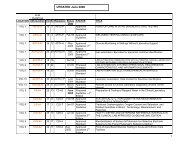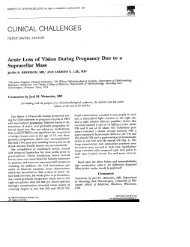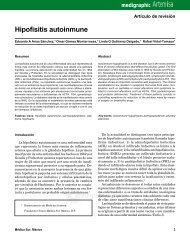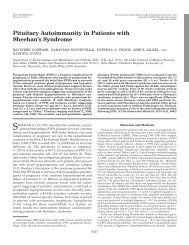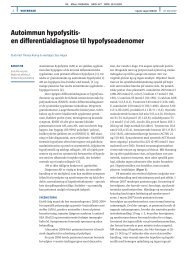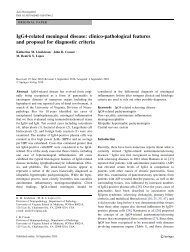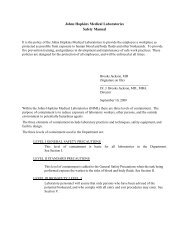View PDF - Johns Hopkins Pathology
View PDF - Johns Hopkins Pathology
View PDF - Johns Hopkins Pathology
Create successful ePaper yourself
Turn your PDF publications into a flip-book with our unique Google optimized e-Paper software.
106 S. Ertek & G. ErdoganGynecol Endocrinol Downloaded from informahealthcare.com by JHU John <strong>Hopkins</strong> University on 05/19/10For personal use only.improves the course of rheumatoid arthritis, Gravesdisease and Type1 diabetes mellitus, on the other sideworsens Wegener syndrome [9–12]. Lymphocytichypophysitis and postpartum thyroiditis are twounique examples of autoimmune diseases that thepregnancy is directly related with disease onset.Lymphocytic hypophysitis can also be accompaniedby other autoimmune diseases, like Addison disease,Type 1 diabetes mellitus, Graves disease, systemiclupus erythematosus, Sjogren syndrome, autoimmunehepatitis, primary biliary cirrhosis and as inother autoimmune diseases there may be relapsingand remitting course, and spontaneous recovery hasalso been reported [13].Searching the Embase and Pubmed both for the allcase reports and reviews about the co-existence ofthese two postpartum diseases in same patient, withkey words ‘postpartum hypophysitis’, ‘postpartumthyroiditis’, ‘lymphocytic hypophysitis’, ‘pregnancy’and ‘hypophysitis’ and ‘thyroiditis’, we found that itwas reported in the same pregnancy of a patient in thecase report of Bevan et al. [14], another report of bothdiseases was presented by Iwaoka in 2001 [15].In this article we present a case with a 9 years storyof follow-up during two successive pregnancies.Case presentationIn 1999, a 26-years-old female patient without anyhistory of thyroid disease has applied to Endocrinologyand Metabolic Diseases Department with complaintsof fatigue and increase in weight at her fifthmonth of postpartum period, during lactation. Herstory of menstruation was regular with age ofmenarche at 15 years, and she did not have anyproblem during her pregnancy and the labour. Onphysical examination she had diffuse goiter withoutpalpable nodules. On laboratory tests, free T4:9.59 ng/dl (Normal range:10–23 ng/dl), free T3:4.38 ng/dl (Normal range: 2.8–7 ng/dl), TSH (thyroid-stimulatinghormone): 18.6 mcIU/ml (Normalrange:0.27–4.20 mcIU/ml), TPO antibody: 365 IU/ml (Normal range: 0.01–34 IU/ml) and Thyroglobulinantibody: 1945 IU/ml (Normal range: 0.01–115 mIU/ml). She had the diagnosis of postpartumthyroiditis and L-thyroxine treatment was started.When she was being followed up with the diagnosisof permanent autoimmune thyroiditis with hypothyroidismafter post-partum period, under L-thyroxinereplacement, she had her second delivery at September2004. After the second delivery, she had thecomplaints of polydipsia, polyuria, prolonged lactation,weight loss, tiredness and she came toendocrinologist in January 2005 when these complaintsincreased. With water deprivation test she hadthe diagnosis of central diabetes insipitus. In herhypophyseal magnetic resonance (MR) imaging,hyperintensity of neurohypophysis was disappeared.She had started desmopressin spray with the diagnosisof central diabetes insipitus. Later, she hadnoticed that she had amenorrhea for 26 months afterdelivery, and 10 kg weight gain within last 6 monthsand her lactation continues although she was notgiving breast feeding. She applied to her gynaecologistand endocrinologist with these complaints inDecember 2006. The tests revealed mild hyperprolactinemiaand on February 2007 she had startedbromocriptin (Table I).At her control visit on December 2007, she had thecomplaint of oligomenorrhea and she was takingmedical treatment for hypothyroidism and centraldiabetes insipitus. Her bromocriptin treatment waschanged and cabergoline and lynesterol was started.She did not have complaint of galactorhea. Her testsfor anterior hypophysis had revealed a suspicion forhypophyseal insufficiency and she was hospitalizedfor dynamic tests and evaluation for hypophysealinsufficiency (Table I).Table I. Laboratory tests of the patient on December 2006, February and December 2007.Patient’s values(October 2006)Patient’s values(February 2007)Patient’s values(December 2007)Normal range*E 2 42.45 pg/ml 10 pg/ml 12.02 pg/ml 12.5–166*FSH 9.02 mIU/l 1.6 mIU/l 1.4 mIU/l 3.50–12.50*LH 7.6 mIU/ml 0.69 mIU/l 0.76 mIU/ml 2.40–12.6*Prolactin 363 mIU/ml 798 mIU/ml 371.4mIU/ml 102–496TSH 0.17 mIU/ml 0.012 mIU/ml 0.05 mIU/ml 0.27–4.20Free T4 1.35 ng/dl 1.44 ng/dl 1.38 ng/dl 0.93–1.71Anti-TG 360 IU/ml – – 0.01–115Anti-TPO 203 IU/ml – – 0.01–34Urine density 1025 – – 1005–1030ACTH – – 25 pg/ml 10–120 (morning)Cortisol – – 12 mcg/dl 6–25 (morning)GH – – 1.70 mIU/l Adult: 520IGF-1 – – 140 ng/ml 140–400*Normal range for follicular phase of the menstrual cycle.



